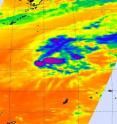Winds blow off Omais' thunderstorm tops
Tropical Storm Omais is fading fast in the northwestern Pacific Ocean, and will dissipate over the weekend according to the Joint Typhoon Warning Center. When NASA's Aqua satellite flew over Omais late on March 25, it already showed signs of falling apart. At 0900 UTC (5 a.m. EDT)on Friday, March 26, Tropical Storm Omais was barely hanging onto tropical storm strength with maximum sustained winds near 39 mph. It was located about 655 nautical miles southwest of the island of Iwo To (formerly Iwo Jima) near 18.3 North and 132.1 East. It was moving north-northeastward at 12 mph (11 knots) and quickly losing its tropical characteristics.
The infrared image from the Atmospheric Infrared Sounder (AIRS) instrument that flies on NASA's Aqua satellite captured an image of Omais on March 25 at 16:53 UTC (12:53 p.m. EDT) and revealed that its convection (rapidly rising air that creates the thunderstorms that power a tropical cyclone) was scattered and limited. It appears as if the convection center of circulation was blown apart – which is exactly what the wind shear had done to those high thunderstorm tops.
There is an upper level trough nearby and that has increased the vertical wind shear has elevated to near 46 mph (40 knots)! The system is expected to become fully extratropical on Saturday, March 27.
Source: NASA/Goddard Space Flight Center
Articles on the same topic
- Imani on the weakening on weekendFri, 26 Mar 2010, 21:22:57 UTC
- Imani reaches cyclone status 'by the tail'Thu, 25 Mar 2010, 17:19:52 UTC
- Tropical storm Omais weakens and doubles in sizeThu, 25 Mar 2010, 17:19:50 UTC
- 02W renamed Tropical Storm Omais, staying at seaWed, 24 Mar 2010, 20:37:29 UTC
- Tropical Storm Imani making a question mark in the Southern Indian OceanWed, 24 Mar 2010, 20:37:28 UTC
- NASA's Aqua Satellite sees a tight Tropical Storm 21STue, 23 Mar 2010, 18:32:28 UTC
- Tropical Depression 02W forms in northwestern PacificMon, 22 Mar 2010, 22:11:08 UTC
Other sources
- Imani on the weakening on weekendfrom Science BlogSun, 28 Mar 2010, 3:14:13 UTC
- Winds blow off Omais' thunderstorm topsfrom Science BlogSun, 28 Mar 2010, 3:14:09 UTC
- Imani on the weakening on weekendfrom PhysorgFri, 26 Mar 2010, 23:07:16 UTC
- Winds blow off Omais' thunderstorm topsfrom PhysorgFri, 26 Mar 2010, 23:07:11 UTC
- Imani on the weakening on weekendfrom Science BlogFri, 26 Mar 2010, 22:21:31 UTC
- Winds blow off Omais' thunderstorm topsfrom Science BlogFri, 26 Mar 2010, 22:21:29 UTC
- Tropical storm Omais weakens and doubles in sizefrom Science BlogThu, 25 Mar 2010, 17:50:38 UTC
- Imani reaches cyclone status 'by the tail'from Science BlogThu, 25 Mar 2010, 17:50:30 UTC
- Imani reaches cyclone status 'by the tail'from PhysorgThu, 25 Mar 2010, 17:50:02 UTC
- Tropical storm Omais weakens and doubles in sizefrom PhysorgThu, 25 Mar 2010, 17:22:38 UTC
- 02W renamed Tropical Storm Omais, staying at seafrom PhysorgWed, 24 Mar 2010, 21:14:08 UTC
- Tropical Storm Imani making a question mark in the Southern Indian Oceanfrom PhysorgWed, 24 Mar 2010, 20:49:17 UTC
- Tropical Storm Imani making a question mark in the Southern Indian Oceanfrom Science BlogWed, 24 Mar 2010, 20:28:39 UTC
- 02W renamed Tropical Storm Omais, staying at seafrom Science BlogWed, 24 Mar 2010, 20:28:37 UTC
- NASA's Aqua Satellite sees a tight Tropical Storm 21Sfrom Science BlogTue, 23 Mar 2010, 20:07:16 UTC
- NASA's Aqua Satellite sees a tight Tropical Storm 21Sfrom PhysorgTue, 23 Mar 2010, 19:14:24 UTC
- Tropical Depression 02W forms in northwestern Pacificfrom Science BlogTue, 23 Mar 2010, 4:28:26 UTC
- Tropical Depression 02W forms in northwestern Pacificfrom PhysorgMon, 22 Mar 2010, 22:21:06 UTC
- Tropical Depression 02W forms in northwestern Pacificfrom Science BlogMon, 22 Mar 2010, 22:07:17 UTC
